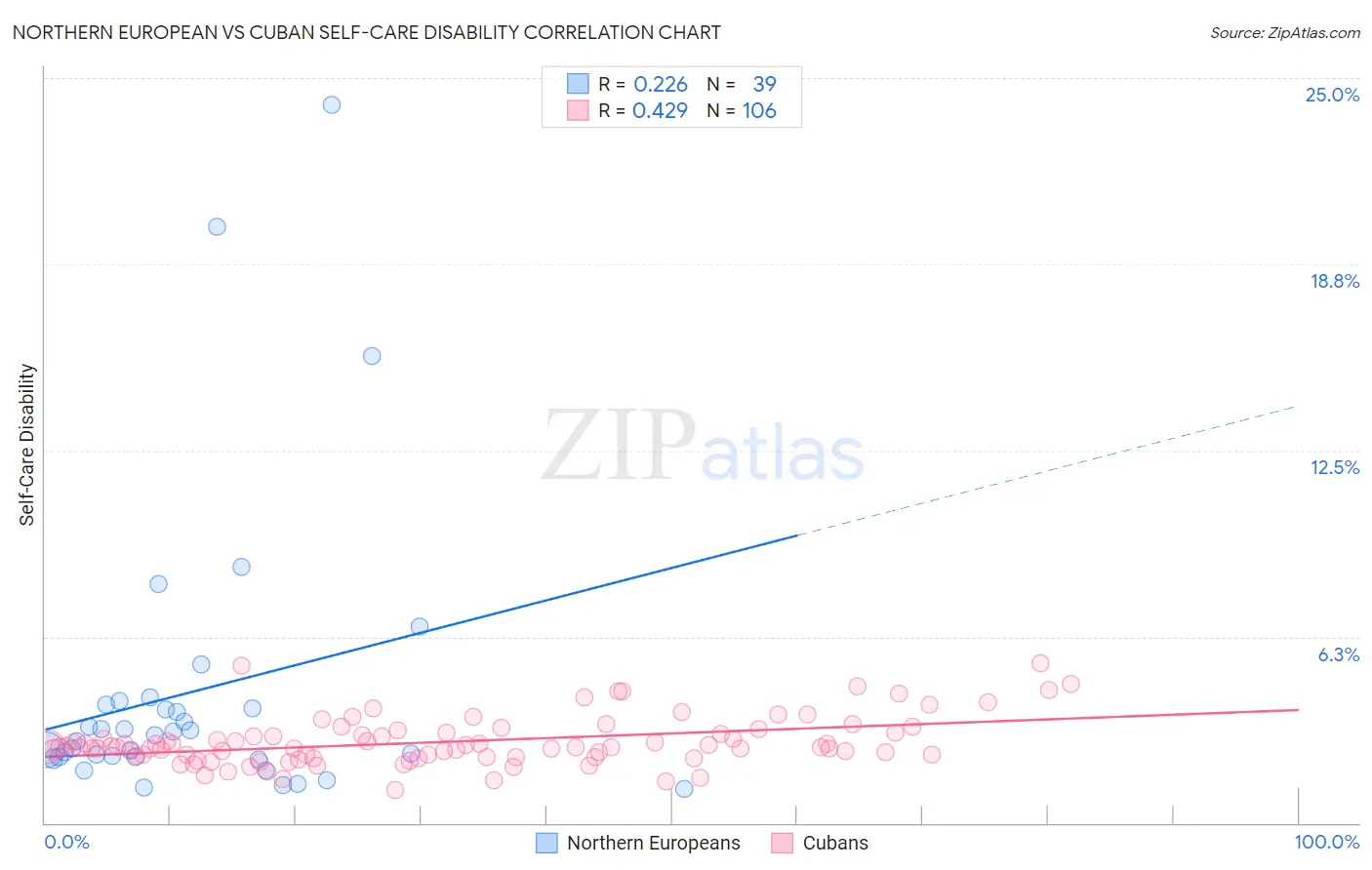Northern European vs Cuban Self-Care Disability
COMPARE
Northern European
Cuban
Self-Care Disability
Self-Care Disability Comparison
Northern Europeans
Cubans
2.4%
SELF-CARE DISABILITY
92.9/ 100
METRIC RATING
116th/ 347
METRIC RANK
2.7%
SELF-CARE DISABILITY
0.0/ 100
METRIC RATING
290th/ 347
METRIC RANK
Northern European vs Cuban Self-Care Disability Correlation Chart
The statistical analysis conducted on geographies consisting of 405,623,897 people shows a weak positive correlation between the proportion of Northern Europeans and percentage of population with self-care disability in the United States with a correlation coefficient (R) of 0.226 and weighted average of 2.4%. Similarly, the statistical analysis conducted on geographies consisting of 448,682,941 people shows a moderate positive correlation between the proportion of Cubans and percentage of population with self-care disability in the United States with a correlation coefficient (R) of 0.429 and weighted average of 2.7%, a difference of 14.2%.

Self-Care Disability Correlation Summary
| Measurement | Northern European | Cuban |
| Minimum | 1.2% | 1.1% |
| Maximum | 24.1% | 5.4% |
| Range | 22.9% | 4.3% |
| Mean | 4.4% | 2.7% |
| Median | 3.0% | 2.5% |
| Interquartile 25% (IQ1) | 2.2% | 2.2% |
| Interquartile 75% (IQ3) | 4.0% | 3.0% |
| Interquartile Range (IQR) | 1.8% | 0.80% |
| Standard Deviation (Sample) | 4.9% | 0.82% |
| Standard Deviation (Population) | 4.9% | 0.81% |
Similar Demographics by Self-Care Disability
Demographics Similar to Northern Europeans by Self-Care Disability
In terms of self-care disability, the demographic groups most similar to Northern Europeans are Immigrants from North Macedonia (2.4%, a difference of 0.050%), Immigrants from Hong Kong (2.4%, a difference of 0.050%), South American (2.4%, a difference of 0.060%), Taiwanese (2.4%, a difference of 0.060%), and Scandinavian (2.4%, a difference of 0.12%).
| Demographics | Rating | Rank | Self-Care Disability |
| Slovenes | 94.1 /100 | #109 | Exceptional 2.4% |
| Immigrants | Africa | 93.7 /100 | #110 | Exceptional 2.4% |
| Serbians | 93.6 /100 | #111 | Exceptional 2.4% |
| Scandinavians | 93.5 /100 | #112 | Exceptional 2.4% |
| South Americans | 93.2 /100 | #113 | Exceptional 2.4% |
| Immigrants | North Macedonia | 93.1 /100 | #114 | Exceptional 2.4% |
| Immigrants | Hong Kong | 93.1 /100 | #115 | Exceptional 2.4% |
| Northern Europeans | 92.9 /100 | #116 | Exceptional 2.4% |
| Taiwanese | 92.5 /100 | #117 | Exceptional 2.4% |
| Immigrants | Canada | 92.0 /100 | #118 | Exceptional 2.4% |
| Immigrants | Sierra Leone | 91.8 /100 | #119 | Exceptional 2.4% |
| Uruguayans | 91.5 /100 | #120 | Exceptional 2.4% |
| Peruvians | 91.3 /100 | #121 | Exceptional 2.4% |
| Belgians | 90.9 /100 | #122 | Exceptional 2.4% |
| Immigrants | Nigeria | 90.3 /100 | #123 | Exceptional 2.4% |
Demographics Similar to Cubans by Self-Care Disability
In terms of self-care disability, the demographic groups most similar to Cubans are African (2.7%, a difference of 0.15%), Immigrants from Barbados (2.7%, a difference of 0.25%), Guyanese (2.7%, a difference of 0.26%), Immigrants from Jamaica (2.7%, a difference of 0.29%), and Central American Indian (2.7%, a difference of 0.42%).
| Demographics | Rating | Rank | Self-Care Disability |
| Delaware | 0.0 /100 | #283 | Tragic 2.7% |
| Fijians | 0.0 /100 | #284 | Tragic 2.7% |
| Jamaicans | 0.0 /100 | #285 | Tragic 2.7% |
| French American Indians | 0.0 /100 | #286 | Tragic 2.7% |
| Immigrants | Jamaica | 0.0 /100 | #287 | Tragic 2.7% |
| Immigrants | Barbados | 0.0 /100 | #288 | Tragic 2.7% |
| Africans | 0.0 /100 | #289 | Tragic 2.7% |
| Cubans | 0.0 /100 | #290 | Tragic 2.7% |
| Guyanese | 0.0 /100 | #291 | Tragic 2.7% |
| Central American Indians | 0.0 /100 | #292 | Tragic 2.7% |
| Belizeans | 0.0 /100 | #293 | Tragic 2.7% |
| Blackfeet | 0.0 /100 | #294 | Tragic 2.7% |
| Barbadians | 0.0 /100 | #295 | Tragic 2.7% |
| Immigrants | Portugal | 0.0 /100 | #296 | Tragic 2.8% |
| West Indians | 0.0 /100 | #297 | Tragic 2.8% |